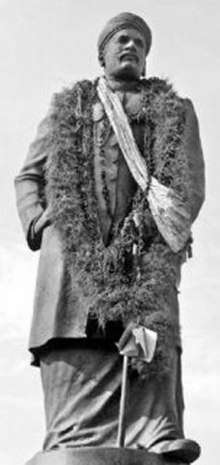Guruvayur Satyagraha
Guruvayur Satyagraha took place in (1931–32) and was a Satyagraha (non-violent protest) in present Thrissur district, which was then part of Ponnani Taluk of Malabar district, now part of Kerala, which was an effort to allow entry for untouchables into the Guruvayur Temple. It was led by K. Kelappan, who undertook a hunger strike for 12 days, until it was abandoned because of a request from Mahatma Gandhi and the Indian National Congress.() Mahatma Gandhi hailed it as "the miracle of modern times" and "a smriti which is peoples charter of spiritual emanicipation". K. Kelappan, A.K Gopalan (volunteer captain), P. Krishna Pillai, Mannathu Padmanabhan and N.P Damodaran Nair were the leaders of that agitation. It was a failure, For another four years, nothing much changed in Guruvayur or in the rest of the region that today constitutes the State of Kerala. It was only in 1936 that many temples in Kerala were opened for all to use.
When Samuthiri, the temple trustee was reluctant to concede as the second phase of the struggle K.Kelappan and manathu padmanbhan started fast unto death from 22 September 1932 onwards. But due to Gandhiji's intervention on 2 October the struggle was withdrawn. According to Gandhi, Kelappan had committed two errors. In the first instance, he ought to have previously consulted Gandhi, as an expert director in matters like fast, but he failed to do so; secondly, he should have given the Zamorin (Temple guardians) reasonable notice of his intention to go on fast. Gandhi felt coercion in Kelappan’s fast.[1]
Subsequently, there was an opinion poll held at Ponnani taluk in which 77 per cent favoured the entry of all castes in to the temples. Leaders, from various parts of Kerala, were later in leadership of C. Rajagopalachari and other Indian national congress leaders such as P. Krishna Pillai and A. K. Gopalan, took part in the effort. The right to enter temples was granted to "Backward" Hindus like Ezhavas only in 1936 in India by the Maharajah of Travancore and the Temple Entry Proclamation.[2][3]
References
- "Chapter 5" (PDF). Retrieved 10 March 2020.
- "Welcome to Guruvayur.. The Bhooloka vaikunda". Archived from the original on 23 November 2009. Retrieved 22 January 2007.
- "Archived copy". Archived from the original on 11 December 2004. Retrieved 22 January 2007.CS1 maint: archived copy as title (link)
External links
- Kerala Cafe: Kerala History
- JSTOR: Temple-entry Movement in Travancore by Robin Jeffrey - requires JSTOR access beyond first page.
